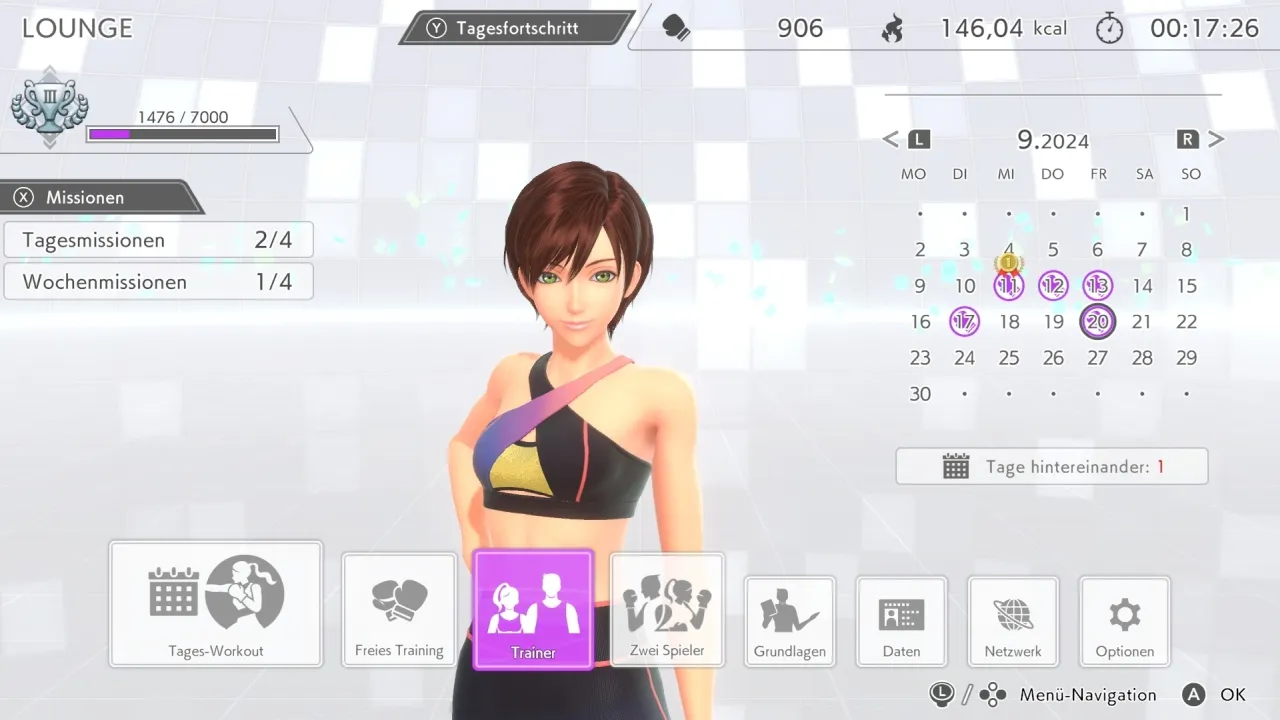“Fitness Boxing 3: Your Personal Trainer” stands at the crossroads of gaming and fitness, appealing to both casual players looking for a fun way to exercise and committed fitness fans looking for an interesting workout. The goal of this game is not to take players to fantastical worlds like most games do but to “gamify” physical activity by making the boring job of exercising into a rhythmic and interactive experience.
Using the Nintendo Switch’s motion controls, players get fully immersed in punch-based workouts led by virtual teachers. The mechanics of the game emphasize a combination of rhythm and timing, echoing the fundamental ideas of rhythm games while offering a distinctive twist that requires physical effort.
The game adapts workouts to individual needs as players enter their personal information and fitness goals, fostering a sense of agency that keeps players motivated. This review will go into more detail about how these mechanics fit in with the main goal of the game, which is to make fitness available and enjoyable for everyone.
The Mechanics of Movement: Dissecting Gameplay in Fitness Boxing 3
When playing “Fitness Boxing 3: Your Trainer,” the Joy-Con controls are the main way to interact with the game and keep track of your workouts. An intense experience that feels both challenging and interesting is created by motion sensors tracking each punch thrown.
This reliance on movement, however, also calls for caution. Players are highly encouraged to secure their Joy-Cons to avoid accidents, similar to the idea that players should be aware of their surroundings while exercising. As players must actively engage with their surroundings, this aspect of control not only enhances the game’s physicality but also gives it a more realistic feel.
The format of the game is very well thought out, with a smooth flow from the warm-up to the main workout and the cool-down. This three-step method is similar to conventional fitness routines, allowing players to gradually increase their exercise intensity while easing into it. A competitive edge reminiscent of rhythm games like “Just Dance” is introduced by the score system, which assesses players based on the timing and rhythm of their punches.
These dance games, on the other hand, focus on technique accuracy, while “Fitness Boxing 3” focuses on fitness. This may give you a sense of accomplishment without a strict review of your form. This design choice may feel for casual playersfree, but fitness fans who really want a more complex feedback system might not be happy with it. The features ultimately help players enjoy movement, improving both the emotional and thematic effects of leading an active lifestyle.
A Spectrum of Sweat: Exploring Exercise Modes in Fitness Boxing 3
The Daily Workouts are the main component of “Fitness Boxing 3: Your Personal Trainer,” a feature created to accommodate the preferences of each player while fostering a sense of commitment. Players can tailor their workout plans to their own personal fitness levels by choosing from a range of workout lengths and speeds.
That way, this flexibility can be used by both casual players who just want a quick lesson and serious fitness fans who want to push their limits. By allowing players to set the pace and focus of their workouts, the game fosters a sense of ownership and progress, where each session feels like a step toward personal goals rather than a one-size-fits-all workout.
Sit Fit Boxing’s introduction further enhances accessibility by providing a mode just for people who have trouble moving around or want to exercise more laid-back. Players can engage in the same punch-based activities while sitting comfortably in their chairs with this choice for sitting.
This mode is important in inclusivity, ensuring that a wider audience can participate in the fitness experience, despite some critics criticizing it for its reduced physical intensity. This well-thought-out design choice fits with the game’s overall narrative, which is about making fitness enjoyable and doable for everyone, regardless of their physical abilities.
In contrast to the Daily Workouts’ rhythmic structure, Mitt Drills emphasizes simple punching exercises that increase the intensity of the workouts. This lets players use combinations without worrying about timing, which can be a relief for people who find the rhythm part hard. Playing in this mode is bolder; players should focus on speed and power instead of accuracy.
A purer representation of physicality is possible without rhythmic cues, which appeals to people who want a more traditional boxing workout. “Fitness Boxing 3” achieves this by successfully balancing its various modes, ensuring that players can find a road that resonates with their fitness journey while reinforcing the emotional benefits of movement.
Personalizing Your Path: Customization and Progress Tracking in Fitness Boxing 3
By allowing users to customize their in-game trainers, “Fitness Boxing 3: Your Personal Trainer” increases player engagement to a new level. Players can create a trainer that resonates with their style by changing their appearance and attire, fostering a stronger emotional connection to the workout experience.
This customization enhances the player’s fitness journey narrative, making each session feel like it was made just for them. By spending money on their trainer’s look, players can live out the dream of having a personal coach, making workouts more fun and motivating them to do better.
The game’s progress tracking system is built in and keeps track of calories burned, workout data, and personal goals. This feature is a physical representation of the player’s efforts, allowing for a sense of accomplishment that is essential to keeping players motivated.
“Fitness Boxing 3” encourages players to set and achieve important goals by offering detailed feedback after each session. Players can see how they’ve changed thanks to this feedback loop, reminiscent of character progression systems in role-playing games, reinforcing the narrative of personal growth and fitness achievement.
Opening the Ring: Accessibility Features in Fitness Boxing 3
“Fitness Boxing 3: Your Personal Trainer” excels in its commitment to accessibility, ensuring that players of all fitness levels can truly engage with the game.
Adding modes like Sit Fit Boxing is especially helpful for people who have trouble moving around or would rather exercise more gently. This well-thought-out design choice encourages a larger audience to participate, reinforcing the narrative that fitness can be enjoyable and attainable for everyone, not just athletes.
The game also allows users to customize their workout intensities based on their skills. This flexibility is crucial because it allows players to progress at their own pace, fostering a sense of agency frequently lacking in conventional fitness programs. “Fitness Boxing 3” respects and meets the needs of more serious fitness enthusiasts by incorporating these easily accessible options, enhancing the casual game experience for casual users.
In a world where many fitness games don’t consider inclusivity, this one stands out by providing a welcoming environment for all players. The physical challenges of boxing are well balanced by the mental comfort of knowing that anyone can start their fitness journey without feeling left out or overwhelmed.
The Sound and Vision of Fitness Boxing 3: An Audio-Visual Evaluation
“Fitness Boxing 3: Your Personal Trainer” has a bright and lively look that is typical of Nintendo’s approach to family-friendly design. The graphics are simple and fun, offering a polished appearance that successfully captures the energizing feel of a boxing workout.
The graphics do what they’re supposed to do, but they lack the unique style that can elevate the emotional engagement of a game. In contrast to the fluid movement expected in a boxing game, character animations during workouts can occasionally feel a little stiff. This small gap could make the experience less engaging, as players might want their actions in the game to be shown in a more expressive way.
The game’s music, which has gotten mixed reviews, goes with its graphics. There are a lot of different tracks, but the quality of the music isn’t very good. It sounds more like generic MIDI versions than polished compositions. This might take away from the motivational effect of music in a workout setting.
However, the audio feedback during workouts is commendable; the motivating voice of the trainer and the rhythmic cues provide a sense of engagement that enhances the workout play experience. The sound design effectively supports the game’s narrative of personal growth and achievement, telling players that every punch they throw is a step toward their fitness goals despite the shortcomings in the music.
Staying in the Ring: Engagement and Motivation in Fitness Boxing 3
“Fitness Boxing 3: Your Trainer” excels at encouraging players to stick to a regular workout schedule and engaging them in the process. How players do in the game is based on the timing, rhythm, and accuracy of their hits, which is a big part of the experience. Each workout becomes a game-like challenge thanks to this immediate feedback, which also serves as a benchmark for growth.
Players are pushed to beat their old scores, creating an interesting loop that rewards hard work and perseverance. This system works a lot like systems in role-playing games (RPGs), where leveling up and improving your skills give you a satisfying sense of progress.
Interaction with trainers enhances motivation; their positive feedback and tailored advice help foster a sense of community. The virtual trainers in Fitness Boxing 3 provide a reassuring presence, making players feel responsible for their progress, in contrast to traditional fitness programs that can feel lonely. As players frequently find themselves invested in their trainers’ personalities and advice, this connection adds an emotional layer to the game.
The game’s structure, with daily routines and workouts that can be changed to fit your needs, also appeals to casual and serious players. Players can change their intensity and focus, ensuring that each workout feels like it fits with their personal fitness journey.
As it enables users to evolve their workout experience alongside their fitness goals, this adaptability is crucial for keeping long-term engagement. Ultimately, “Fitness Boxing 3” does a good job of creating an inspiring setting that makes players want to keep returning to the ring, making fitness feel less like a chore and more exciting.
Final Round: Evaluating Fitness Boxing 3
That’s why “Fitness Boxing 3: Your Personal Trainer” stands out as a fun fitness tool that mixes game mechanics with workout patterns well. Its main strengths are customizable workouts and motivational features like scoring systems and trainer interactions, which promote a sense of achievement and responsibility.
The accessibility features, such as options for different fitness levels, ensure inclusivity by allowing a wide range of players to truly engage with the game.
While fun, the audiovisual presentation lacks exceptional quality that could elevate the whole experience. The music is usually pretty bland, which might make the workout less motivating. Some movements could also use more fluidity to make them more immersive.
Despite these flaws, the game does well getting players to stick to a fitness program. The combination of fun and fitness in “Fitness Boxing 3” encourages physical activity and builds a positive emotional link to exercise, making it an important part of any fitness fanatic’s routine.
The Review
Fitness Boxing 3: Your Personal Trainer
"Fitness Boxing 3: Your Trainer" does a good job of combining fun gameplay with workouts that can be changed to fit your needs. The game's supportive narrative and engaging trainer experience keep players motivated. It excels in accessibility and user motivation, but the audiovisual components aren't quite up to par. Overall, it does a good job of promoting fitness in a fun and welcoming way, making it useful for casual and serious users.
PROS
- Engaging and customizable workout routines.
- Supportive trainer interactions enhance motivation.
- Accessible features for various fitness levels.
CONS
- Audio-visual presentation lacks standout quality.
- Some animations feel stiff and less immersive.
- Music tracks can be generic and uninspiring.






















































